Clouds part, solar eclipse darkens north Australia
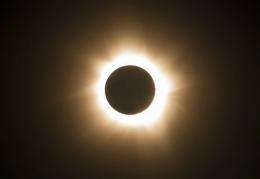
From boats bobbing on the Great Barrier Reef, to hot air balloons hovering over the rainforest, and the hilltops and beaches in between, tens of thousands of scientists, tourists and amateur astronomers watched as the sun, moon and Earth aligned and plunged northern Australia into darkness during a total solar eclipse Wednesday.
Stubborn clouds that many feared would ruin the view parted—somewhat—in north Queensland, defying forecasts of a total eclipse-viewing bust and relieving spectators who had fanned out to glimpse the celestial phenomenon.
"Immediately before, I was thinking, 'Are we gonna see this?' And we just had a fantastic display—it was just beautiful," said Terry Cuttle of the Astronomical Association of Queensland, who has seen a dozen total solar eclipses over the years. "And right after it finished, the clouds came back again. It really adds to the drama of it."
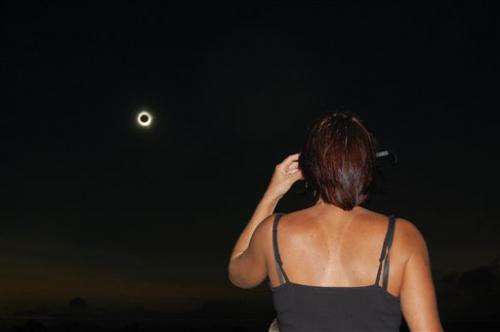
Spectators whooped and clapped with delight as the moon passed between the sun and Earth, leaving a slice of the continent's northeast in sudden darkness.
Starting just after dawn, the eclipse cast its 150-kilometer (95-mile) shadow in Australia's Northern Territory, crossed the northeast tip of the country and was swooping east across the South Pacific, where no islands are in its direct path. A partial eclipse was visible from east Indonesia, the eastern half of Australia, New Zealand, Papua New Guinea and southern parts of Chile and Argentina. Totality—the darkness that happens at the peak of the eclipse—lasted just over two minutes in the parts of Australia where it was visible.
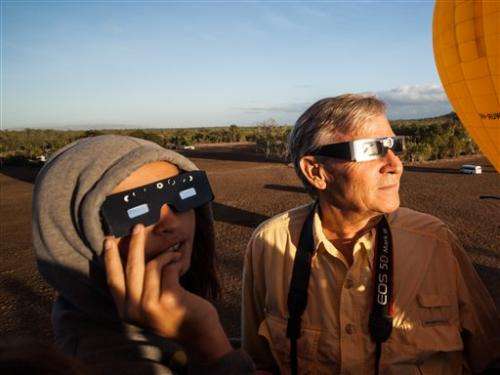
Gloomy weather had left many eclipse-chasers who had traveled to Australia from around the globe anxious that they wouldn't be able to see a thing. But the clouds moved in time for many to watch as the moon blotted out the sun's rays and cast a shadow over the tropical landscape.
Hank Harper, 61, and his two children flew from Los Angeles just to see the eclipse, and feared the clouds would ruin their adventure. The three of them hopped on board a hot air balloon with other eager tourists and staff from Hot Air Balloon Cairns, crossed their fingers—and were rewarded with a perfect view.
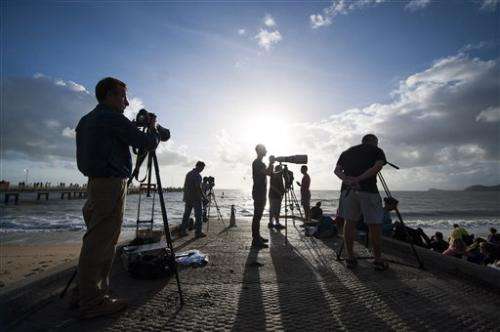
"We gambled everything—drove through the rain and didn't even know if the balloon was going to go up," he said by phone from the hot air balloon as he and Harrison, 10, and Reilly, 12, watched the sun's rays re-emerge from behind the moon while kangaroos hopped on the ground below. "It was everything I could have hoped for."
On a dive-boat drifting along the blue waters of the Great Barrier Reef, a cheer of relief erupted as the clouds moved away at the moment of total eclipse, followed by a hush as darkness fell across the water. One scuba diver floated on his back in the sea, watching the phenomenon unfold as he bobbed in the waves. Birds on a nearby island, startled by the sudden lack of light, began to stir.

"It was absolutely amazing. We were coming out this morning and there was a wee bit of cloud around and we were apprehensive," Adam O'Malley of the Passions of Paradise dive company said by phone from his boat. "We got a full view—absolutely breathtaking."
Some Queensland hotels have been booked up for more than three years and more than 50,000 people flooded into the region to watch the solar spectacle, said Jeff Gillies, regional director of Queensland Tourism.
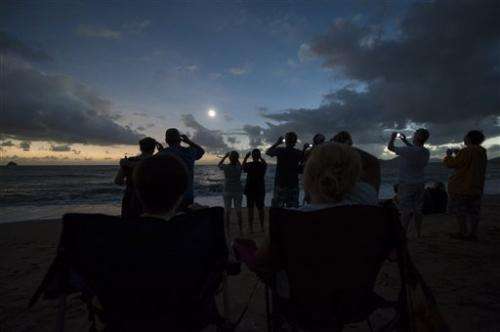
Skygazers crowded along palm-fringed beaches, fields and clifftops to watch the event through protective viewing glasses and homemade pinhole cameras that projected the sun's image onto makeshift screens. Fitness fanatics gathered for the Solar Eclipse Marathon, where the first rays of the sun re-emerging from behind the moon was the starting gun. Some began partying days ago at a weeklong eclipse festival.
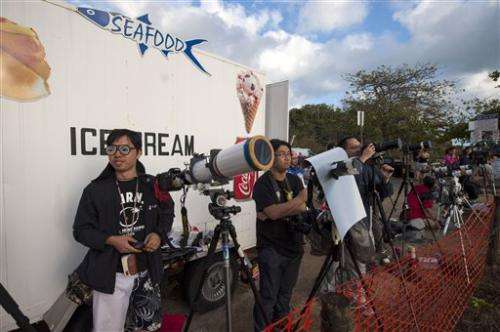
Scientists were studying how animals respond to the eclipse, with underwater cameras capturing the effects of sudden darkness on the creatures of the Great Barrier Reef.
The next total solar eclipse won't happen until March 2015.
Copyright 2012 The Associated Press. All rights reserved. This material may not be published, broadcast, rewritten or redistributed.


















